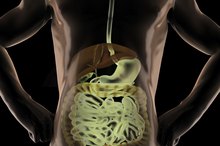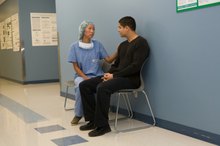What does fact checked mean?
At Healthfully, we strive to deliver objective content that is accurate and up-to-date. Our team periodically reviews articles in order to ensure content quality. The sources cited below consist of evidence from peer-reviewed journals, prominent medical organizations, academic associations, and government data.
The information contained on this site is for informational purposes only, and should not be used as a substitute for the advice of a professional health care provider. Please check with the appropriate physician regarding health questions and concerns. Although we strive to deliver accurate and up-to-date information, no guarantee to that effect is made.
How to Tell If Your Liver Is Enlarged?
The human liver acts as a kind of screening system for the body, processing toxins from food, alcohol and other substances we consume or absorb. An adult liver rivals a football in size; under most circumstances, you won't feel it through or below the ribcage. Hepatomegaly, the medical term for an enlarged liver, is an underlying sign of liver disease such as hepatitis, as well as a host of other medical conditions, including mononucleosis and some forms of cancer 12. Heed the signs of an enlarged liver; if necessary, your doctor can diagnose enlarged liver through physical examination, medical history and imaging technologies 1.
If you are experiencing serious medical symptoms, seek emergency treatment immediately.
Know the symptoms associated with an enlarged liver—common symptoms include abdominal pain and tenderness 1. Look for yellowed skin or eye whites: a condition called jaundice that commonly points to liver disease and may occur in conjunction with liver enlargement.
Causes of Spots on the Liver
Learn More
Evaluate your bathroom habits and appetite to determine whether you may show signs of liver disease, a series of medical conditions characterized by a swollen liver. Watch for very dark urine, blood in the stool, little or no appetite and nausea—all possible indicators.
Perform a self-exam to determine whether your liver is bigger than it should be. In most cases, a normal liver does not extend past the bottom of your ribcage unless you take deep breath, according to the National Institutes of Health. Palpitate (gently press down on) the area below your ribs; if you can feel the organ with your fingers, you likely have a swollen liver.
End Stage Liver Disease Life Expectancy
Learn More
Take into consideration any behaviors that may increase your risk of developing liver disease. According to the American Liver Foundation, women should limit their intake of alcoholic beverages to one each day to lower their risk of liver disease. Most men can safely indulge in two drinks daily to maintain liver health. Avoid recreational injectable drugs and unsafe sex, which can also heighten your risk of contracting hepatitis. If you fall into any of these risk groups and experience other symptoms consistent with liver disease, you may be suffering from an enlarged liver 1.
Schedule a physical exam with your doctor so she can determine whether you have an enlarged liver 1. She will examine you visually, take into account any risk factors from your lifestyle, and may order imaging tests such as X-rays and sonography to determine the size of your liver. Diagnostic technology can also reveal growths that indicate of liver cancer or other illness.
Give blood samples to measure liver function. An enlarged liver due to an underlying medical condition may compromise proper liver function 1. Your doctor may also require tissue samples to determine the cause of an enlarged liver 1.
Related Articles
References
- Mayo Clinic, enlarged liver
- Medline Plus, hepatomegaly
- Cleveland Clinic. Enlarged Liver. Updated September 7, 2018.
- Centers for Disease Control and Prevention. What is Viral Hepatitis? Updated
- Centers for Disease Control and Prevention. Enlarged Liver: Diagnosis and Tests. Updated September 7, 2018.
- Nassir F, Rector RS, Hammoud GM, Ibdah JA. Pathogenesis and Prevention of Hepatic Steatosis. Gastroenterol Hepatol (N Y). 2015;11(3):167–175.
- Merck Manual Professional Version. Alcoholic Liver Disease. Updated July 2019.
- Madrazo BL. Using imaging studies to differentiate among benign liver tumors. Gastroenterol Hepatol (N Y). 2010;6(7):423–427.
- Cong WM, Bu H, Chen J, et al. Practice guidelines for the pathological diagnosis of primary liver cancer: 2015 update. World J Gastroenterol. 2016;22(42):9279–9287. doi:10.3748/wjg.v22.i42.9279
- Memorial Sloan Kettering Cancer Center. Liver Metastases (Secondary Liver Cancer). Updated
- Cleveland Clinic. Glycogen Storage Disease (GSD). Updated August 2, 2019.
Writer Bio
Erica Roth has been a writer since 2007. She is a member of the Society of Professional Journalists and was a college reference librarian for eight years. Roth earned a Bachelor of Arts in French literature from Brandeis University and Master of Library Science from Simmons College Graduate School of Library and Information Science. Her articles appear on various websites.









